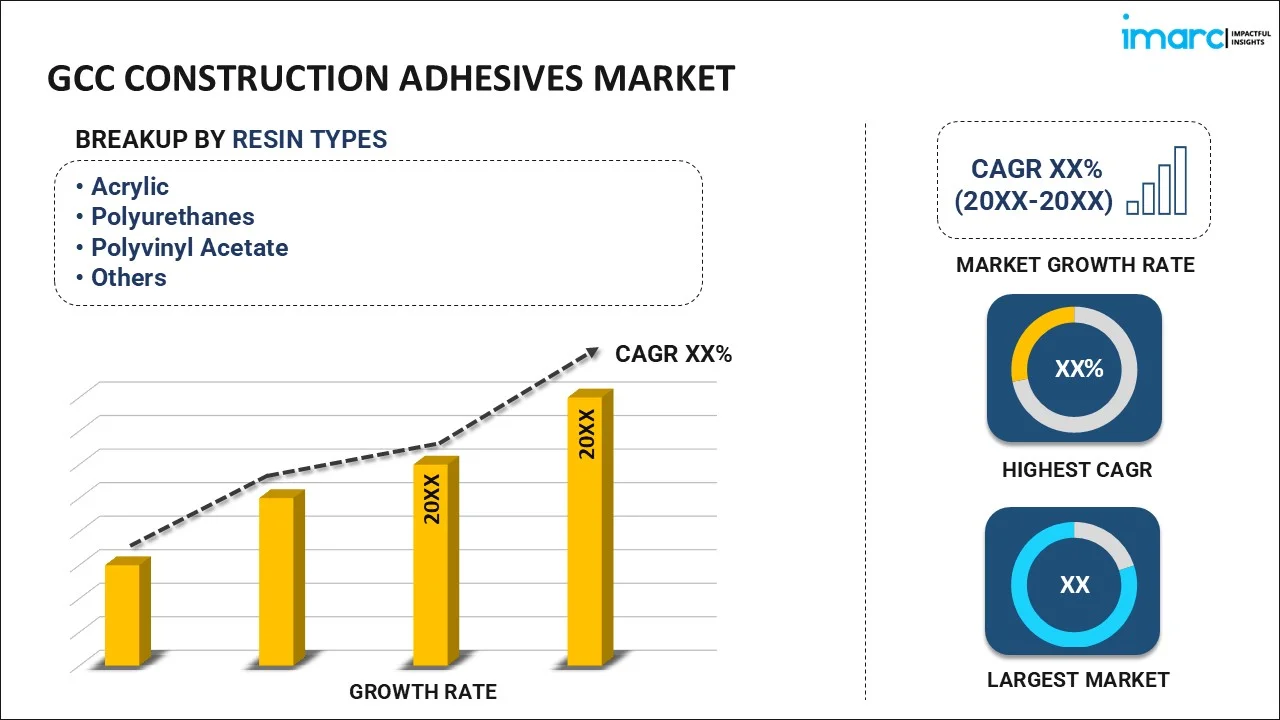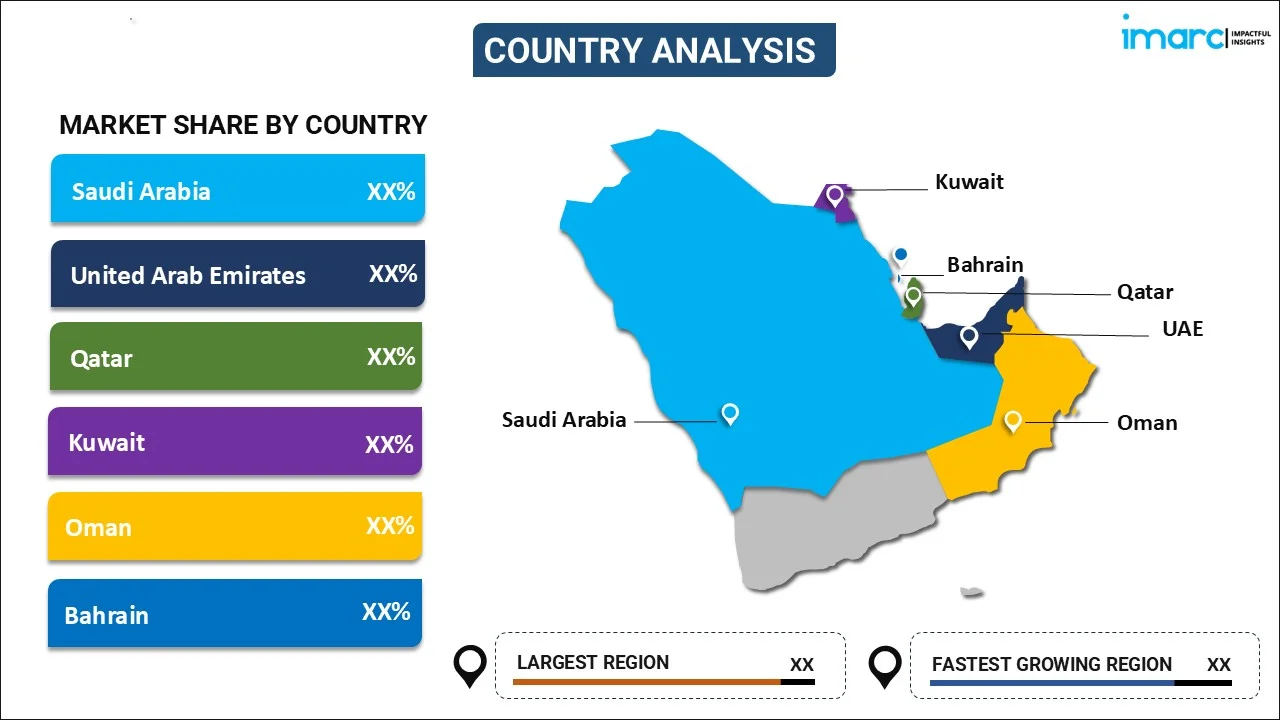
GCC Construction Adhesives Market Report by Resin Type (Acrylic, Polyurethanes, Polyvinyl Acetate, Epoxy, and Others), Technology (Water-based, Solvent-based, Reactive, and Others), Application (Residential, Commercial, Industrial), and Country 2025-2033
GCC Construction Adhesives Market Overview:
The GCC construction adhesives market size reached USD 281.06 Million in 2024. Looking forward, IMARC Group expects the market to reach USD 466.84 Million by 2033, exhibiting a growth rate (CAGR) of 5.40% during 2025-2033. Rapid urbanization and infrastructure development, rising construction activities, implementation of various government initiatives, growing demand for energy-efficient buildings, ongoing technological advancements, and rising awareness of sustainability and eco-friendly materials are some of the key factors impelling the market growth.
|
Report Attribute
|
Key Statistics
|
|---|---|
|
Base Year
|
2024
|
|
Forecast Years
|
2025-2033
|
|
Historical Years
|
2019-2024
|
| Market Size in 2024 | USD 281.06 Million |
| Market Forecast in 2033 | USD 466.84 Million |
| Market Growth Rate 2025-2033 | 5.40% |
GCC Construction Adhesives Market Trends:
Demand for Sustainable and Eco-friendly Building Materials
The rising demand for sustainable building materials in the GCC region due to government regulations and energy-efficient goals is significantly contributing to the market expansion. Construction companies and contractors are under pressure to adopt materials that reduce environmental impact due to the growing consumer demand for eco-friendly adhesives that contribute to energy-efficient buildings. Additionally, the introduction of new formulations of low-volatile organic compounds (VOC) and non-toxic adhesives to meet these green building standards is acting as another significant growth-inducing factor. Furthermore, the implementation of sustainable building standards such as Leadership in Energy and Environmental Design (LEED), driven by the need for enhanced insulation properties and reduced energy consumption, is fueling the market growth.
Advancements in Adhesive Technologies
Technological innovation in adhesive formulations, such as the development of high-performance adhesives with enhanced bonding strength, faster curing times, and improved durability, is another factor driving the market growth. Manufacturers are introducing high-performance construction adhesives for applications like floor installations, wall panels, glass bonding, and heavy-duty construction, offering higher efficiency and lower costs in construction processes. Besides this, the introduction of smart adhesives with self-healing properties or enhanced resistance to ultraviolet (UV) radiation, humidity, and heat is providing an impetus to the market growth. Furthermore, the growing demand for multifunctional adhesives is pushing companies to invest in research and development (R&D) to introduce new, more versatile products, thus supporting the market expansion.
Expansion of Infrastructure Development and Construction Projects
The rapid growth of infrastructure projects across the GCC countries, driven by government-led initiatives such as Saudi Arabia's Vision 2030, is creating significant demand for construction adhesives. These initiatives are transforming the region's urban landscape, with a focus on the development of large-scale residential, commercial, and industrial structures, along with major transportation networks. Adhesives provide fast, reliable, and durable bonding solutions in these applications, improving project timelines and reducing costs. Moreover, the rise in real estate and construction activities creating a demand for a wide variety of adhesive products designed for diverse applications, such as flooring, wall cladding, and roofing systems is impelling the market growth. Besides this, the growth in high-rise buildings and advanced architectural designs spurring the need for specialized adhesives that provide superior bonding for different substrates and materials, is propelling the market forward.
GCC Construction Adhesives Market News:
- In May 2023, H.B. Fuller Company acquired XCHEM International LLC, an adhesives manufacturer in the United Arab Emirates (UAE), offering a wide range of specialty adhesives and coatings for industrial and infrastructure applications in the Middle East and Northern Africa.
GCC Construction Adhesives Market Segmentation:
IMARC Group provides an analysis of the key trends in each segment of the market, along with forecasts at the country level for 2025-2033. Our report has categorized the market based on resin type, technology, and application.
Resin Type Insights:

- Acrylic
- Polyurethanes
- Polyvinyl Acetate
- Epoxy
- Others
The report has provided a detailed breakup and analysis of the market based on the resin type. This includes acrylic, polyurethanes, polyvinyl acetate, epoxy, and others.
Technology Insights:
- Water-based
- Solvent-based
- Reactive
- Others
A detailed breakup and analysis of the market based on the technology have also been provided in the report. This includes water-based, solvent-based, reactive, and others.
Application Insights:
- Residential
- Commercial
- Industrial
The report has provided a detailed breakup and analysis of the market based on the application. This includes residential, commercial, and industrial.
Country Insights:

- Saudi Arabia
- United Arab Emirates
- Qatar
- Kuwait
- Oman
- Bahrain
The report has also provided a comprehensive analysis of all the major regional markets, which include Saudi Arabia, United Arab Emirates, Qatar, Kuwait, Oman, and Bahrain.
Competitive Landscape:
The market research report has also provided a comprehensive analysis of the competitive landscape. Competitive analysis such as market structure, key player positioning, top winning strategies, competitive dashboard, and company evaluation quadrant has been covered in the report. Also, detailed profiles of all major companies have been provided.
GCC Construction Adhesives Market Report Coverage:
| Report Features | Details |
|---|---|
| Base Year of the Analysis | 2024 |
| Historical Period | 2019-2024 |
| Forecast Period | 2025-2033 |
| Units | USD Million |
| Scope of the Report | Exploration of Historical Trends and Market Outlook, Industry Catalysts and Challenges, Segment-Wise Historical and Future Market Assessment:
|
| Resin Types Covered | Acrylic, Polyurethanes, Polyvinyl Acetate, Epoxy, Others |
| Technologies Covered | Water-based, Solvent-based, Reactive, Others |
| Applications Covered | Residential, Commercial, Industrial |
| Countries Covered | Saudi Arabia, United Arab Emirates, Qatar, Kuwait, Oman, Bahrain |
| Customization Scope | 10% Free Customization |
| Post-Sale Analyst Support | 10-12 Weeks |
| Delivery Format | PDF and Excel through Email (We can also provide the editable version of the report in PPT/Word format on special request) |
Key Questions Answered in This Report:
- How has the GCC construction adhesives market performed so far and how will it perform in the coming years?
- What has been the impact of COVID-19 on the GCC construction adhesives market?
- What is the breakup of the GCC construction adhesives market on the basis of resin type?
- What is the breakup of the GCC construction adhesives market on the basis of technology?
- What is the breakup of the GCC construction adhesives market on the basis of application?
- What are the various stages in the value chain of the GCC construction adhesives market?
- What are the key driving factors and challenges in the GCC construction adhesives?
- What is the structure of the GCC construction adhesives market and who are the key players?
- What is the degree of competition in the GCC construction adhesives market?
Key Benefits for Stakeholders:
- IMARC’s industry report offers a comprehensive quantitative analysis of various market segments, historical and current market trends, market forecasts, and dynamics of the GCC construction adhesives market from 2019-2033.
- The research report provides the latest information on the market drivers, challenges, and opportunities in the GCC construction adhesives market.
- Porter's five forces analysis assist stakeholders in assessing the impact of new entrants, competitive rivalry, supplier power, buyer power, and the threat of substitution. It helps stakeholders to analyze the level of competition within the GCC construction adhesives industry and its attractiveness.
- Competitive landscape allows stakeholders to understand their competitive environment and provides an insight into the current positions of key players in the market.
Need more help?
- Speak to our experienced analysts for insights on the current market scenarios.
- Include additional segments and countries to customize the report as per your requirement.
- Gain an unparalleled competitive advantage in your domain by understanding how to utilize the report and positively impacting your operations and revenue.
- For further assistance, please connect with our analysts.
 Inquire Before Buying
Inquire Before Buying
 Speak to an Analyst
Speak to an Analyst
 Request Brochure
Request Brochure
 Request Customization
Request Customization




.webp)




.webp)












